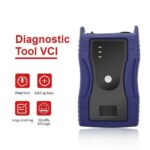This guide provides a step-by-step tutorial on building your own ALDL OBD2 scan tool for around $30. This custom tool allows you to read diagnostic trouble codes (DTCs) from your OBD1 vehicle using a readily available OBD2 connector and an FTDI chip. Understanding the Aldl Obd2 Pinout is crucial for this project, as it dictates the wiring configuration for successful data transmission.
Building Your ALDL OBD2 Scanner: A Step-by-Step Guide
This project repurposes an OBD2 connector to interface with the ALDL protocol used in OBD1 vehicles. By connecting an FTDI chip to specific pins on the OBD2 connector, we can create a bridge between the vehicle’s diagnostic port and a computer. Let’s dive into the process.
Gathering the Necessary Components
-
OBD2 to USB Cable: Purchase a readily available OBD2 to USB cable. This provides the OBD2 connector and exposes convenient solder points. While not strictly necessary, using a connector minimizes the risk of short circuits in your vehicle’s Diagnostic Link Connector (DLC).
-
FTDI Breakout Board: Acquire an FTDI breakout board equipped with an FT232RL chip. This board facilitates communication between the OBD2 connector and your computer via USB. Ensure the board supports 5V operation, crucial for this application.
-
Micro USB Cable: A standard micro USB cable is required to connect the FTDI breakout board to your computer.
-
Tools: Assemble basic soldering tools, including a soldering iron, solder, wire strippers, and cutters, along with a small Phillips head screwdriver.
Modifying the OBD2 Connector
-
Disassemble the OBD2 Cable: Carefully open the OBD2 to USB cable housing using the Phillips head screwdriver.
-
Detach the Circuit Board: Separate the internal circuit board from the OBD2 connector. This may require gently bending the connector back and forth or using wire cutters to sever the connecting tabs.
-
Remove Pin Headers: Remove the metal pin headers from the back of the OBD2 connector to expose the solder pads. Use wire cutters or desolder them. Prevent the solder pads from touching each other.
Wiring the FTDI Breakout Board
-
Prepare the USB Cable: Cut off the USB end of the OBD2 cable and strip the outer insulation and shielding to expose the internal wires. You will utilize three wires: black (ground), white, and green. The red wire is not needed for this project.
-
ALDL Data Line (Pin 9): Twist the green and white wires together and solder them to pin 9 on the OBD2 connector. Pin 9 carries the ALDL data stream, handling both transmission and reception.
-
Ground Connection (Pin 5): Solder the black wire to pin 5 on the OBD2 connector, establishing the ground connection.
-
FTDI Connections: Solder the combined white/green wire to either the TXD or RXD pin on the FTDI breakout board (it doesn’t matter which, as it’s a closed loop). Solder the black wire to a GND pin on the FTDI board.
Conclusion
This guide demonstrated how to build a cost-effective ALDL OBD2 scan tool. By understanding the ALDL OBD2 pinout and following these steps, you can create a valuable tool for diagnosing issues in your OBD1 vehicle. Remember to double-check all connections before use.

